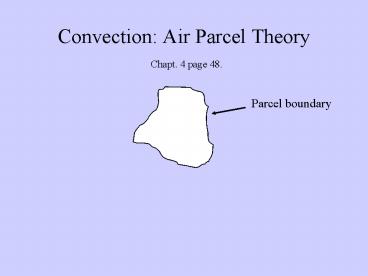Convection: Air Parcel Theory Chapt' 4 page 48' - PowerPoint PPT Presentation
1 / 27
Title:
Convection: Air Parcel Theory Chapt' 4 page 48'
Description:
Observations of cumuli indicate towers grow for a while, ... 3. Extension of Cumulus mass. Initial mass. Spherical cap completely eroded and no longer buoyant. ... – PowerPoint PPT presentation
Number of Views:227
Avg rating:3.0/5.0
Title: Convection: Air Parcel Theory Chapt' 4 page 48'
1
Convection Air Parcel Theory Chapt. 4 page 48.
Parcel boundary
2
Convection Parcel Theory
- Vertical motion of parcels of air.
- Bouyant convection leads to the formation of
cumulus clouds (though other clouds have
convective features). - Parcel theory is an elementary treatment, but
useful for qualitative understanding.
3
Parcel Theory Assumptions
- Parcel and environment are in dynamic
equilibrium P P. - Parcel maintains its identity no mixing with
environment. - Atmosphere in hydrostatic equilibrium.
- No compensating motion by atmosphere as parcel
moves.
4
Parcel theory equations
5
(No Transcript)
6
Alternate formulation using gtgt
7
(No Transcript)
8
Correcting for Condensed H2O
Let
9
Parcel Theory is Useful for
- Estimating cloud base and top heights
- Estimating stability
- Estimating vertical motion U
- But weve neglected
- Drag
- Mixing
- Compensating motion by environment
- Effects of condensed water
- Therefore parcel theory U gt expected upper
limit.
10
Dilution by Entrainment
Lateral entrainment mix cooler, drier air
through clouds lateral
boundaries. Effects Reduce T T
Reduce w
11
Cloudy Air of mass m consists of dry air, water
vapor and condensed water. Assume that as cloudy
air ascends a distance dz, a mass dm of
environmental air is entrained. Condensed water
in the cloud will evaporate in response to the
entrainment of drier air. Primes will denote
properties of ambient (environmental) air.
12
Heat Required to warm the entrained air from T
to T
(neglect heat content of vapor and liquid)
Assume that just enough condensate evaporates to
saturate the mixture. Let
13
(No Transcript)
14
Substituting in the values for each individual
heat transfer and rearranging
With no entrainment (dm 0) we recover the
parcel theory result
So for a bouyant parcel with entrainment, we see
that the magnitude of dq/q is larger than the
pure parcel result. Temperature falls off at a
faster rate buoyancy is impaired.
15
If instead of solving for q we solved for dT/dz
we obtain
16
An Example
17
Aircraft observations show T T in many clouds.
It is possible to integrate to find m(z) for
specified Gp and f. Results show the cloud mass
may easily double or triple in a few km of
ascent. Lab measurements of man-made buoyant
plumes bear out the theory. But theres a
problem
18
The observations suggest downdrafts within cloud
which dilute by entrainment of dry ambient air
above cloud top.
19
(No Transcript)
20
(No Transcript)
21
Bubble Theory
Observations of cumuli indicate towers grow for a
while, lose their impetus and are succeeded by
new ones. This phenomena led Scorer (1958) to
propose what is known as the Bubble Theory of
convection.
22
Life Cycle of a Cumulus Cloud
1. Initial Ascent
23
2. Erosion of spherical cap and mixing of
ambient and bubble air.
Erosion of cap
Turbulent wake
Lateral mixing and entrainment
Cumulus mass
24
3. Extension of Cumulus mass
25
Net Result of Bubble Cycle
The bubble has enriched the ambient air above the
original cloud (moistened the environment). Thus
the next bubble can penetrate further than the
first. Successive bubbles extend the cloud
further in the vertical direction.
26
Cumuli and Horizontal Winds
Wake carried downstream
z
wind
Greatest vertical growth is on down-shear side.
z
Verified by observation
27
(No Transcript)































